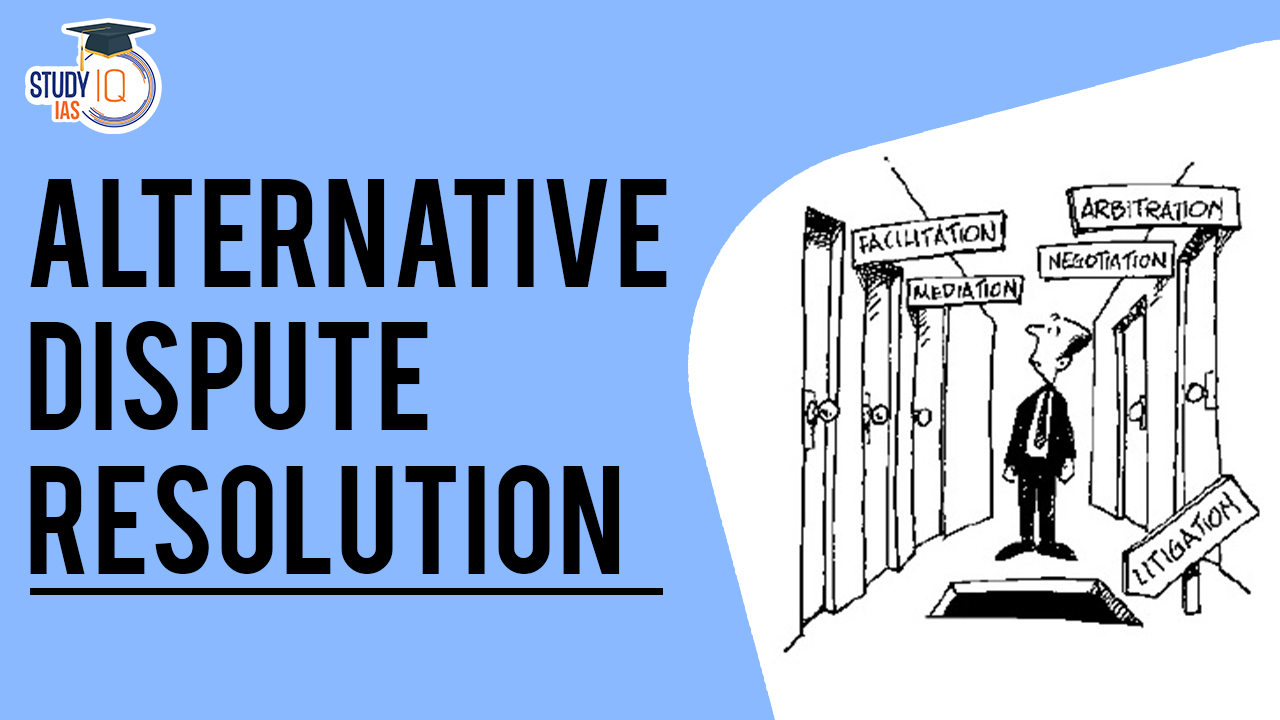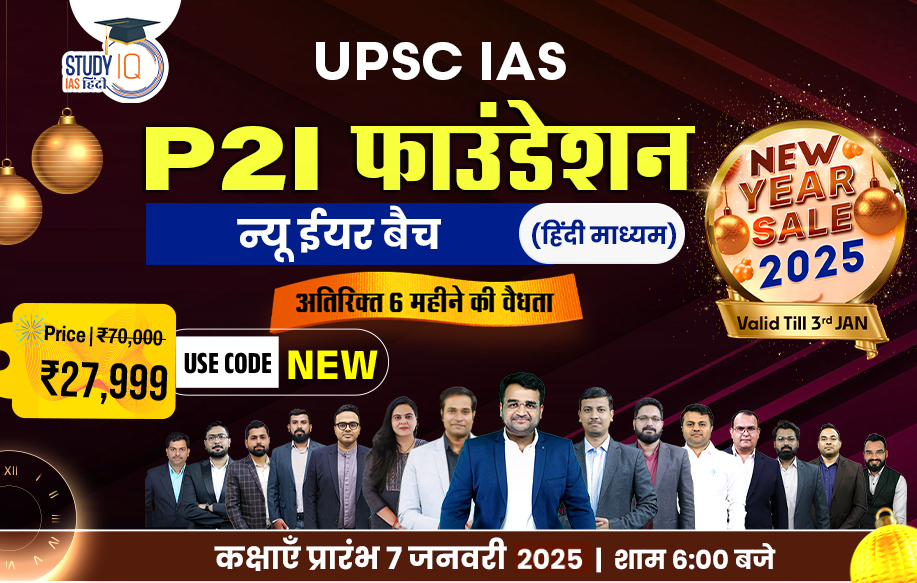Table of Contents
Alternative Dispute Resolution
Today’s world is globalized and tech-driven, allowing people to communicate and settle business deals from anywhere. Many individuals lack the time to file court papers and wait for hearings. As a result, alternative dispute resolution (ADR) is becoming more popular than traditional litigation, which has its drawbacks. While India has not fully shifted to ADR, the legal system is starting to recognize its advantages. This article will provide an overview of ADR methods and their benefits.
Alternative Dispute Resolution which is covered in this article is covered in the Indian Polity and Governance of UPSC Syllabus. Students can also go for UPSC Mock Test to get more accuracy in their preparations.
Alternative Dispute Resolution Meaning
Alternative dispute resolution (ADR) includes various ways to settle disagreements without going to court. These methods often involve a third party who helps the parties reach a settlement. ADR can also be used alongside the court process with court approval. It is an effort to develop a system that is distinct from the customary methods of dispute resolution. The objective of the alternative dispute resolution mechanism is to aid in the settlement of commercial disputes and other conflicts where no attempt has been made to engage in constructive dialogue or reach a mutually agreeable conclusion.
Alternative Dispute Resolution is protected by the Indian Constitution’s Articles 21 (Right to life and personal liberty) and 14 (Equality before the law). The Directive Principles of State Policy (DPSP) of equal justice and free legal aid, which are enshrined in Article 39-A of the Indian Constitution, can also be accomplished through ADR. It can assist courts in lightening a load of litigation while giving the parties concerned a satisfying and well-rounded experience.
The Origins of ADR
According to the 222nd Report of the Law Commission of India, the Constitution guarantees access to justice for everyone through Article 39A, ensuring that no citizen is denied justice due to economic or other disadvantages.
However, many people in India face barriers to accessing courts due to poverty, illiteracy, ignorance, and social issues. Many cannot afford long legal battles or lawyers and often find the court system overwhelming.
These challenges are common in many countries, leading to the exploration of alternative dispute resolution (ADR). The Indian courts are also burdened with a huge number of pending cases, causing delays.
To address these issues, the Indian Government introduced Section 89 of the Code of Civil Procedure, 1908, and replaced the Arbitration Act of 1940 with the Arbitration and Conciliation Act, 1996, in line with the guidelines of the United Nations Commission on International Trade Law (UNCITRAL).
Alternative Dispute Resolution Types
Alternative Dispute Resolution is categorized as follows:
Arbitration
Arbitration in India is governed by the Arbitration and Conciliation Act, 1996. It’s a way to resolve disputes where one or more neutral third parties, called arbitrators, make decisions. Their decision is known as an “arbitration award.” The arbitration process is informal, making it quicker and cheaper than going to court. This is why many people, especially in business, prefer arbitration to avoid lengthy legal battles.
Before arbitration starts, the parties must create an arbitration agreement. This agreement outlines the terms and conditions of the process, including how to keep it efficient and affordable. It must comply with the Indian Contract Act, 1972, ensuring that the parties have the capacity to contract.Arbitration decisions are final and binding, meaning parties can’t easily challenge them. However, non-binding arbitration is also available, allowing a party to request a trial if they’re not satisfied with the arbitrator’s decision.
Conciliation
In conciliation, a neutral third party called the conciliator speaks with each party separately to help them find a solution they both agree on. Conciliation in India is governed by the Arbitration and Conciliation Act, 1996. According to Section 61, it applies to disputes from legal relationships, whether they are based on a contract or not.
Mediation
In mediation, a neutral third party called the mediator helps two or more people in a dispute reach a settlement. The mediator communicates with both sides and uses negotiation techniques to help each party understand the other’s viewpoint through empathy and dialogue. The process is controlled by the parties involved.
A key feature of mediation is that the mediator does not decide the outcome; the solution is agreed upon by the parties, and the agreements are usually non-binding. The mediation process is confidential, and parties can choose to go to court if they’re not satisfied with the outcome.
The main goal of mediation is to improve relationships rather than to make a decision. It focuses on amicably resolving differences, allowing for potential future business between the parties.
Negotiations
Negotiation is a way to resolve disputes without a third party. Instead, the parties involved work together to find a solution or compromise. They can have attorneys represent them during negotiations. In India, negotiation is not officially recognized, and there are no specific rules for it.
Essentials of Negotiation:
- It’s a communication process to resolve conflicts.
- Participation is voluntary, and the results are non-binding.
- The parties control the outcome and process, focusing on their interests.
Judicial Settlements Inclusive Of Lok Adalats
The Lok Adalat system of dispute resolution was created in order to expedite the procedure and was made possible by the Legal Services Authorities Act of 1987. At Lok Adalat, disagreements might be settled without going to court. It is a part of the Alternative Dispute Resolution (ADR) system, which offers quick, inexpensive, and informal justice to the general population.
Alternative Dispute Resolution Pros and Cons
Pros of ADR:
Cost-effective: It’s cheaper than going to court.
Time-saving: Resolutions happen more quickly.
Less formal: It avoids the complex rules of the court system.
Open discussion: Parties can freely share their views without fear of legal consequences.
Preserves relationships: There’s no clear winner or loser, so relationships can remain intact for future dealings.
Great for multiple parties: Everyone can share their views at once, making discussions easier.
Choice of method: Parties can often choose how they want to resolve their dispute and who will help them.
Flexible process: The approach can be tailored to suit the parties’ needs.
Confidential: Discussions can remain private, focusing on practical solutions.
Broader issues: A wider range of concerns can be addressed, protecting future interests.
Risk management: Helps manage potential risks involved in disputes.
Cons of ADR:
Limited use of precedents: It’s not effective when past court decisions are needed.
Lack of court authority: Not useful if court orders are necessary.
Enforcement challenges: It’s harder to enforce agreements made through ADR.
Expert evidence needed: Not suitable for cases that require detailed expert analysis.
Power imbalances: ADR may not work well if one party is much stronger than the other.
Complex cases: Detailed cases requiring close scrutiny might need more formal adjudication.
Alternative Dispute Resolution in India
With the use of new conflict resolution techniques like Alternative Dispute Resolution (ADR), parties can settle their differences more cheaply and effectively. These techniques also have the advantage of allowing parties to reduce antagonism, regain control, win acceptance of the judgment, settle disputes amicably, and achieve a greater feeling of fairness in each case.
The Legal Services Authorities Act and the new Arbitration and Conciliation Act were both passed in an effort to promote out-of-court settlements. The Code of Criminal Procedure included a system for plea negotiations in 2005. A “pre-trial settlement between the accused and the prosecution in which the accused offers to plead guilty in exchange for specific concessions from the prosecution” is known as a “plea bargaining arrangement.”
Lok Adalat, or “people’s court,” is a relaxed setting that promotes conversations in the presence of a judge and enables problems to be solved without heavily emphasizing legalese. The decision of the Lok-decision Adalat is final, enforceable against the parties, and cannot be contested in court.
Alternative Dispute Resolution Limitation
The appeals process for awards is constrained or nonexistent. There is no way to contest or change the prize if it is flawed. Selecting from the many rules and organizations that provide arbitration services might be difficult. It is challenging to identify how international arbitration regulations should be applied because domestic and international arbitration are governed by distinct statutes.
It is challenging to bridge the gap and arrive at a shared solution because the two regions have different languages and cultures. Many people still like the old method of appearing in court, and many are also uninformed of these options and the procedure.
Conclusion
There are various dispute resolution methods like med-arb, mini trials, and summary jury trials, but arbitration, mediation, and Lok Adalats are the most commonly used in India. While ADR is becoming the preferred choice globally, India still relies heavily on litigation. However, as ADR methods develop and improve access to justice, they are increasingly seen as essential. It’s important to legally recognize all ADR methods, including negotiation, as they are practical and can help reduce the burden on the courts.
Alternative Dispute Resolution UPSC
Alternative Dispute Resolution procedures have its roots in the creation of arbitration rules, which have undergone significant development throughout time. The Indian Parliament was astute enough to integrate these new dispute resolution methods as other ADR procedures started to knock on its door over time. For instance, the Commercial Courts Act of 2015 and the Micro, Small and Medium Enterprises Development Act of 2006 make sure that these processes are used on an individual basis in particular industries.
The Indian government of today is taking extra steps to strengthen ADR procedures with the goal of making India a popular destination for arbitration and other types of conflict resolution on a worldwide scale. Students can read all the details related to UPSC by visiting the official website of StudyIQ UPSC Online Coaching.


 President Droupadi Murmu Appoints New Go...
President Droupadi Murmu Appoints New Go...
 Private Members’ Bills get short shrif...
Private Members’ Bills get short shrif...
 National Commission or Women (NCW), Obje...
National Commission or Women (NCW), Obje...




















